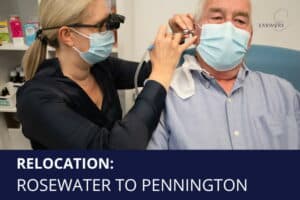If you’ve ever experienced a sensation of fullness in your ears, muffled hearing, or pressure that won’t go away, you’re not alone. One of the most common reasons people ask, “Why do my ears feel blocked?” is due to a build-up of earwax. While earwax plays an important protective role, too much of it can lead to discomfort, hearing issues, and even infections.
In this article, we’ll explain what happens when your ear is blocked with wax, why it occurs, and the safest way to have it removed.
Why are my ears blocked?
There are several potential causes for a blocked ear sensation. These can include:
- Changes in air pressure (such as during flights)
- Fluid in the middle ear
- Sinus congestion from colds or allergies
- Eustachian Tube Dysfunction
However, one of the most common, and often overlooked, causes is earwax impaction.
Eustachian Tube Dysfunction

0:46

0:49

0:50
Why are my ears blocked?
There are several potential causes for a blocked ear sensation. These can include:
- Changes in air pressure (such as during flights)
- Fluid in the middle ear
- Sinus congestion from colds or allergies
- Eustachian Tube Dysfunction
However, one of the most common, and often overlooked, causes is earwax impaction.

Understanding earwax and its role
Earwax (or cerumen) is produced naturally by glands in the ear canal. It protects the ear by trapping dust, debris and microorganisms, and also acts as a natural moisturiser. In most cases, earwax makes its way out of the ear on its own, aided by jaw movement from talking and chewing.
However, for some people, wax can build up and harden, leading to an ear blocked with wax that doesn’t clear naturally.
Why do my ears feel blocked?
When earwax becomes impacted, it can block the ear canal and create a sensation of fullness or pressure, as though something is “stuck” in your ear. This is one of the most common reasons people ask, “Why are my ears blocked?” It may also cause:
- Muffled or reduced hearing
- A “popping” feeling in the ear
- Tinnitus (ringing in the ears)
- Dizziness or balance issues
- Discomfort or a dull ache
If you’re experiencing these symptoms in one or both ears, there’s a chance that earwax build-up is the culprit.
What causes wax build-up?
Some people are more prone to wax build-up than others. Risk factors include:
- Narrow or curved ear canals
- Using cotton buds or earplugs regularly
- Wearing hearing aids or in-ear headphones frequently
- Overproduction of wax due to genetics or skin conditions
- Ageing, which can cause wax to become drier and harder
Contrary to popular belief, cleaning your ears with cotton buds is not recommended for removing wax, as it can actually push wax deeper into the ear canal, increasing the likelihood of impaction.
The safe way to clear a blocked ear
If your ear is blocked with wax, it’s important not to try to fix it yourself with cotton buds, bobby pins, or other objects. These can damage the delicate structures of the ear and make the problem worse.
At Earworx, our team of Registered Nurses specialise in earwax removal using microsuction. This is a gentle, safe, and effective method recommended by ENT specialists. This technique involves using a small suction device, similar to a miniature vacuum, to remove wax under direct visualisation. There’s no water involved, and the process is quick and comfortable for most patients.
When to seek professional help
If you’re unsure why your ears feel blocked, or if symptoms persist for more than a few days, it’s time to consult a professional. You should seek help if you experience:
- Sudden or significant hearing loss
- Persistent fullness in the ears
- Pain, discharge, or odour from the ear
- Dizziness or balance problems
At Earworx, we can assess your symptoms, determine whether earwax impaction is the cause, and clean the ear canal using microsuction.
Don’t live with blocked ears
Having your ear blocked with wax can interfere with your hearing, your balance, and your quality of life. The good news? It’s easily treated.
If you’ve been wondering, “Why are my ears blocked?” or “Why do my ears feel full all the time?”, book an appointment with Earworx today. Our expert nurses are here to help clean your ears and feel comfortable again, without the cotton buds.
Book now to experience safe, professional earwax removal using microsuction. Your ears will thank you.




